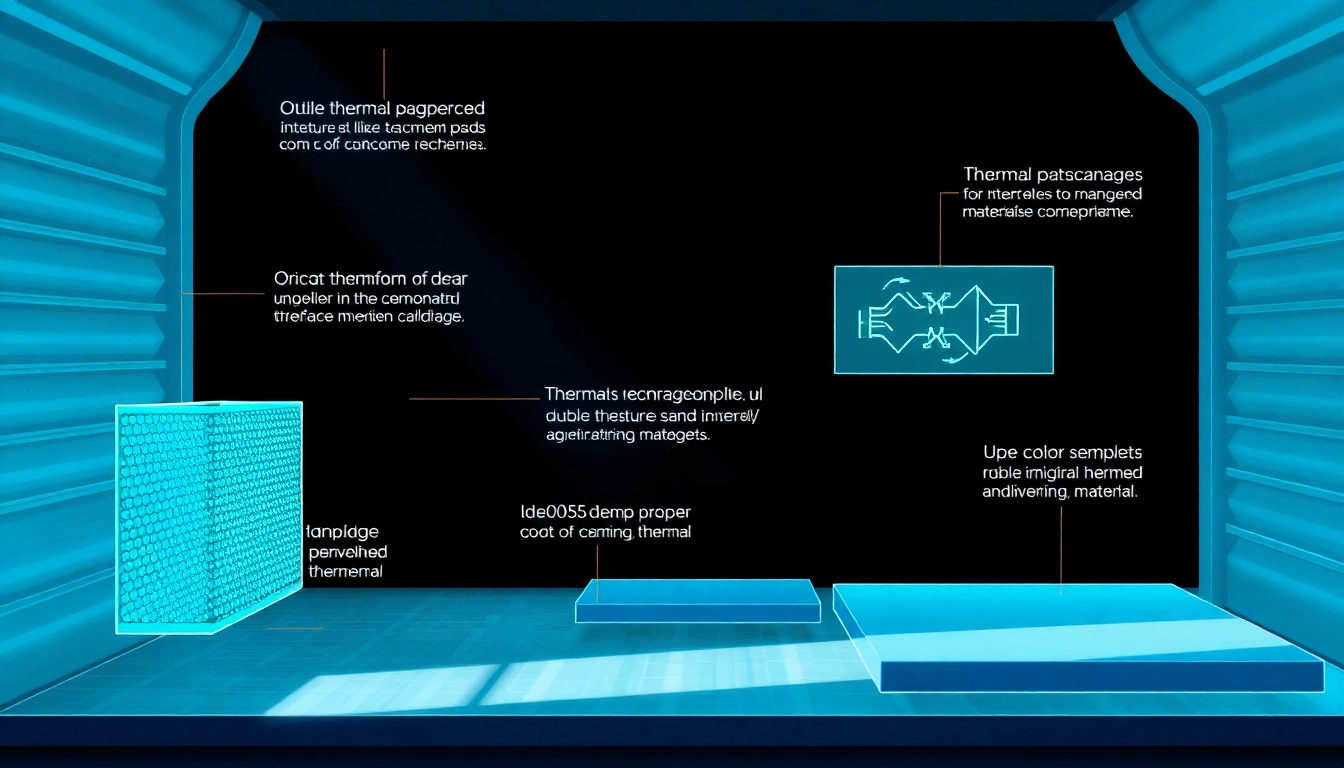Understanding Thermal Management Materials
In the ever-evolving landscape of electronics, managing heat has become increasingly vital. As components shrink in size yet demand higher performance, effective heat dissipation strategies must be tailored to meet these challenges. This is where thermal management materials come into play. These materials encompass a wide variety of products designed to control and dissipate heat in electronic applications, ensuring optimal performance and longevity of devices.
What are Thermal Management Materials?
Thermal management materials refer to a group of materials specifically engineered for the effective transfer, conduction, and dissipation of heat in various electronic systems. They play a crucial role in maintaining temperature stability in devices, preventing overheating, and enhancing efficiency. These materials can be categorized into several types, each serving distinct functions but collectively aimed at improving thermal performance.
Key Properties and Benefits
The effectiveness of thermal management materials can be measured by several key properties:
- Thermal Conductivity: This is the most critical property, describing how well a material conducts heat. High thermal conductivity materials are favored in applications requiring efficient heat dissipation.
- Thermal Resistance: Understanding thermal resistance is essential for evaluating how well materials can resist the flow of heat. Lower resistance indicates better performance.
- Viscoelasticity: This property is particularly important for materials like thermal interface materials (TIMs) that can fill gaps between surfaces to improve heat flow.
- Mechanical Strength: Durability and rigidity are necessary for materials that will be subjected to physical stress in electronic assemblies.
- Chemical Stability: Materials must maintain their properties over time, even when exposed to various environmental factors such as humidity, temperature changes, and chemicals.
In summary, the correct choice of thermal management material can significantly improve the performance, reliability, and lifespan of electronic devices.
Common Applications in Electronics
Thermal management materials are used across various applications in the electronics industry:
- Consumer Electronics: Smartphones, tablets, and laptops require thermal management solutions to handle their compact design and high-performance specifications.
- Automobiles: With the rise of electric vehicles, thermal management materials are instrumental in managing battery heat and ensuring optimal operation of electronic components.
- Telecommunications: Equipment such as routers and cell towers generate significant heat, necessitating effective cooling solutions to maintain performance and reliability.
- Industrial Equipment: Machinery and industrial applications often operate under extreme conditions, where efficient thermal management is essential for reliability.
Types of Thermal Management Materials
Thermal Interface Materials (TIM)
Thermal Interface Materials (TIMs) serve as a bridge between heat-generating components and heat sinks, enhancing thermal transfer efficiency. They are typically applied in minimal thickness to fill microscopic air gaps, which can significantly impede heat flow. Common types of TIMs include:
- Greases: These are paste-like substances that have high thermal conductivity and are easy to apply, making them ideal for situations where parts need to be disassembled.
- Tapes: Pressure-sensitive tapes provide a simple solution for adhering components to heat sinks while conducting heat.
- Pads: These conformable materials are often used in high-performance applications where electrical insulation and thermal conductivity are both required.
When selecting TIMs, factors such as thermal conductivity, viscosity, and ease of application should be considered.
Phase Change Materials (PCM)
Phase Change Materials (PCMs) absorb and release heat as they change from solid to liquid or vice versa. This property allows them to maintain a stable temperature, making them highly effective in applications where thermal spikes are expected. PCMs are often encapsulated in sheets or applied as coatings. Their use is particularly prevalent in:
- Consumer Electronics: Smartphones and laptops often utilize PCMs to regulate temperature without active cooling systems.
- Telecommunications: Servers and data centers deploy PCMs to manage heat build-up, reducing energy costs associated with cooling.
Gap Fillers and Pads
Gap fillers and thermal pads work to bridge the gaps between components, providing an efficient medium for heat dissipation. These materials are typically soft and conformable, allowing them to mold around the surface they are applied to. They are crucial for:
- Electrical Control Units: In automotive applications, gap fillers help maintain optimal temperatures in critical electronic components.
- LED Lighting Solutions: Managing the heat produced by LEDs is vital for performance, and gap fillers are frequently used to facilitate this.
Choosing the Right Thermal Management Material
Factors to Consider When Selecting Materials
Choosing the appropriate thermal management material is not a one-size-fits-all approach; rather, it requires careful consideration of various factors:
- Operating Conditions: Consider the temperature range, environmental exposure, and mechanical stresses that the material will endure.
- Compatibility: Ensure compatibility with surrounding materials, electrical properties, and any impact on device performance.
- Application Specifics: The specifics of the application (such as layer thickness and installation method) play a critical role in material selection.
Evaluating Thermal Conductivity and Resistance
Understanding thermal conductivity (measured in W/mK) is fundamental when evaluating the effectiveness of thermal management materials. The following steps can help determine the appropriate choice:
- Conductivity Tests: Utilize standardized tests (like ASTM or IEC) to assess the thermal conductivity of candidate materials.
- Resistance Calculations: Calculate the thermal resistance using formulas to estimate heat flow through materials based on their thickness and area.
- Real-World Testing: Conduct controlled tests simulating the actual operating conditions of the device to measure performance.
Best Practices for Application
Application methods significantly impact the performance of thermal management materials. Follow these best practices:
- Surface Preparation: Clean surfaces thoroughly to ensure optimal contact and adhesion of materials.
- Consistent Thickness: Aim for a consistent application thickness to avoid creating air pockets that may impact thermal performance.
- Follow Manufacturer Instructions: Adhere to guidelines provided by manufacturers for drying, curing, and performance expectations.
Performance Metrics for Thermal Solutions
How to Measure Heat Dissipation Efficiency
Measuring heat dissipation efficiency is crucial for evaluating thermal management strategies. Key metrics include:
- Temperature Gradient: Measure the difference in temperatures between hot and cold surfaces to assess effectiveness.
- Power Dissipation Testing: During operation, measure the amount of heat generated versus the capability of the thermal management solution to dissipate that heat.
- Thermal Imaging: Utilize thermal cameras to visualize heat distribution and identify potential hotspots.
Testing Standards and Protocols
When testing thermal management materials, adhere to established standards for consistency and reliability. Standards from organizations such as ASTM and IEC provide guidelines for:
- Thermal Conductivity Measurement
- Thermal Interface Material Performance
- Lifecycle Testing
Compliance with these standards ensures your materials meet industry expectations and can substantiate claims made regarding performance.
Analyzing Long-Term Performance
The longevity of thermal management materials is vital for electronics reliability. Conduct long-term tests such as:
- Thermal Cycling Tests: Evaluate how materials perform under repeated heating and cooling cycles.
- Ageing Tests: Assess material degradation over time when exposed to operational conditions.
- Moisture and Chemical Resistance Tests: Ensure materials can withstand environmental challenges without deterioration.
Future Trends in Thermal Management Technologies
Advancements in Material Science
The future of thermal management is promising, with advancements in material science leading the charge. Emerging trends include:
- Nano-Materials: Research into nanotechnology is yielding materials with enhanced thermal conductivity, aiding in miniaturization and performance.
- Smart Materials: The development of materials that change properties in response to temperature variations, providing dynamic thermal management solutions.
- Biodegradable Options: With a growing emphasis on sustainability, research is being conducted to develop thermal materials that minimize environmental impact.
Emerging Applications in Electronics
As electronics continue to integrate into our daily lives, the demand for effective thermal management grows. Some emerging applications include:
- Wearable Devices: As the market for wearables expands, thermal management solutions must adapt to compact, high-performance electronics.
- Internet of Things (IoT): Smart devices require efficient heat management to ensure reliable operation in diverse environments.
Impact of Sustainability on Material Choices
Organizations are becoming increasingly aware of the environmental implications of their material choices in the production of electronics. As such, sustainable thermal management materials are gaining traction:
- Focus on Recyclability: Manufacturers are prioritizing the development of materials that can be recycled at the end of their life cycle.
- Energy-Efficient Manufacturing: Efforts are being made to reduce energy consumption during the production process of thermal materials.
- Reduced Chemical Usage: Striving to minimize harmful substances in thermal solutions aligns with the global move toward safer manufacturing practices.



